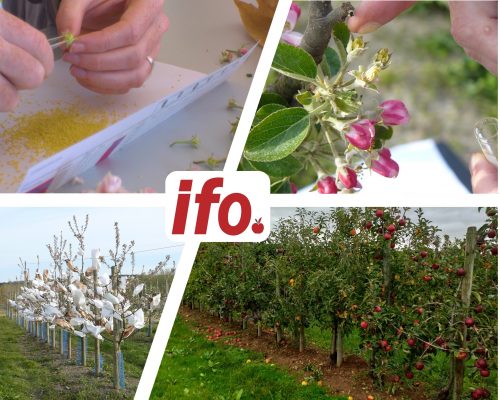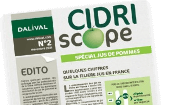 Nous contacter
Nous contacter
Advice
VARIETY CREATION
| Download the advice sheet | |
| « VARIETY CREATION » | |
 |
What is variety creation?
The creation of a new apple variety is a long process. Indeed, 15 to 20 years are necessary to complete all the operations. From the choice of the varieties to be crossed to the selection and tasting of the apples, we present here the main stages of this process which requires precision and patience on the part of the breeder.
POLLINATION
April, year 1
Before blossom, IFO determines the parents to be crossed. For example, to obtain a green variety resistant to scab, the parents chosen will be a green variety on the one hand and a resistant variety on the other hand.
At the early stage of blossom, after removing the petals, the breeder pollinates the flower of the first parent with the pollen of the second parent, with his finger or with a brush.
The pollinated flowers are then protected from bees and wind with sleeves. This ensures that no other pollen ends up on the selected flowers.
STRATIFICATION
January, year 2
The apples are harvested in the autumn, the seeds are removed and put into stratification, i.e. they are potted with wet sand at a temperature of 1 to 2°C to satisfy the cold requirements before germination.
SOWING
February, year 2
The seeds are sown in a glasshouse. Each seed is a potential new variety (hybrid).
SCAB SCREENING
March year 2
The young seedlings are sprayed with a solution containing scab. Susceptible hybrids develop scab and can therefore be excluded from the selection.
The hybrids from this first selection are transplanted.
NURSERY
August, year 2
The hybrids are budded in the nursery.
PLANTATION
December, year 3
The plants are removed from the nursery and planted in the experimental orchard.
VARIETY EVALUATION AND SELECTION
Years 4 to 15
During these years, a rigorous monitoring of the hybrids is carried out. Different characteristics are evaluated, such as eating qualities, fruit texture, colour, as well as architecture, vigour and yield of the tree. Disease resistance/tolerance are also observed. Few varieties pass this selection.
When a hybrid looks interesting, branches are cut to propagate 4 trees (because at this stage there is still only one tree of each variety). On these trees, the repeatability of the previous criteria is checked, but other observations are added: the blossom date, the consistency of production, etc. The fruits are harvested and preserved to evaluate their storage capacity.
For the best hybrids, branches are again cut to propagate larger quantities of trees:
– IFO checks all the criteria mentioned above (agronomy, taste, storage, etc.) on about 50 trees. IFO can start showing the fruit to growers and marketers who can plant the variety. At the same time, the steps for the protection of the variety and the registration in the catalogue are taken.
– IFO sends test trees to different countries / partner stations to check the adaptation of these varieties under different soil and climatic conditions.
COMMERCIAL LAUNCH
Years 15 to 20
Trees of the new variety are multiplied in the nursery to be sold and planted in commercial orchards and the promotion of the new variety can fully begin.
More information: video
*IFO is the research and development station of Dalival.


Archive of Pommoscopes
Request Quotation - VARIETY CREATION
 English
English Français
Français Deutsch
Deutsch Español
Español Italiano
Italiano Русский
Русский Polski
Polski





